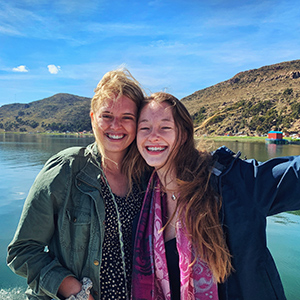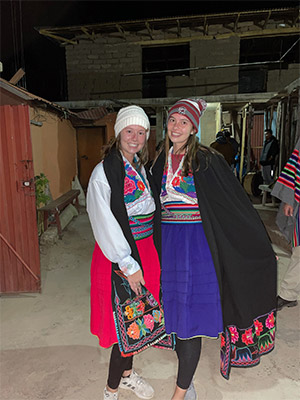

It was Christmas Eve in 2021, but Brynn Lynagh was poring over Spanish-language academic articles on the history of Peruvian food and ancient Inca culture. In just two days, she would be on a flight to Lima, Peru, to take part in an interdisciplinary winter session open to 20 students of all majors and class standings.
Starting in Lima, Peru’s capital, students immersed themselves in city shaped by fusion: The half-indigenous, half-Spanish architecture dates to the 16th century, and even the food is a culinary nod to Peru’s blended heritages. The group then explored Cusco, the capital of the ancient Incan empire, and the nearby sacred site of Machu Picchu. Students toured key sites in Cusco while encountering the living and breathing Inca culture still present in cuisine, dress and the Quechua language spoken by indigenous Peruvians.
This is one of many trips arranged through the Education Abroad Office, all of which enrich the student experience at the University of South Carolina. Over 1,500 undergraduate students travel internationally each year through Education Abroad, visiting 62 different countries across six continents in 2021.
From adventure to knowledge
Peru was not Lynagh’s first experience abroad. In high school, a trip to Ecuador jump-started her passion for travel and Spanish. Throughout her time at USC, the biochemistry and Spanish double-major volunteered with the Good Samaritan Clinic, a defining experience that allowed her to gain health care training while interacting with patients in Spanish.

Choosing Peru was an easy next step: Lynagh would improve her language fluency, explore Peruvian history in Matt Childs’ class on Spanish conquest and the Incan empire, and even connect her travel experiences and her STEM studies. In Cusco, as Lynagh drew parallels between her biochemistry class findings and her altitude sickness symptoms, Childs, a senior faculty associate with the Center for Integrative and Experiential Learning, immediately recognized what he was hearing: the seeds of a Graduation with Leadership Distinction portfolio.
Pursuing the global learning pathway after returning from Peru, Lynagh drew connections between high altitude adaptions and her biochemistry coursework, cultural contact zones in Peru and Spain, and cultural competency in her travels and at the Good Samaritan Clinic. Reflecting intentionally allowed her to elevate the Peru trip from an unforgettable adventure to a powerful learning experience with clearly defined takeaways.
For Lynagh, Peru was a particularly memorable experience in a series of incredible study abroad opportunities, but for others in her cohort, it would be their first time traveling internationally.
First trip overseas
Campbell Farace, a senior majoring in global studies and Spanish, signed up for the trip with high hopes for her first trip outside of the United States. Anticipating a semester in Spain following her time in Peru, she was hoping to transition into living abroad in a Spanish-speaking country. Farace’s time in Peru far exceeded her expectations.

Farace took Ana Cueto’s Spanish immersion class, which focused on culture and emphasized language practice with locals. From negotiating souvenir prices in the Inca market to brushing up on language skills with tour guides, Farace had opportunities to hone both her linguistic and cultural competency in Peru.
Still, among English speaking peers, it was easy to fall back on her native tongue. An excursion to Puno, nestled on the shores of Lake Titicaca, was a class favorite that pushed Farace out of her English comfort zone. The group traveled by boat to a series of floating islands and anchored for the evening at Amantani Island, where they did an overnight stay and partook in cultural rituals with locals.
The class hiked to the top of Amantani island, where they had a spectacular view of Lake Titicaca and the landscape of Bolivia. When they returned to the base of the island, their hosts treated them to traditional meals cooked partially underground in earthenware vessels and a night of dancing in traditional garb. Recognizing the depth and beauty of cultural differences, Farace discovered her own passion for travel and set a goal of someday achieving Spanish fluency.
New perspectives
After Peru, Farace spent a semester in Spain as planned, but Peru will always stand out to her, in large part thanks to its role in her personal growth. “It made me way more open-minded to other cultures and ways of life,” says Farace, who plans to serve as a middle school social studies teacher with Teach for America in Charlotte. “It’s impacted the way that I want to teach my students. I wish I’d learned more about other cultures and how they relate to the United States. That was something I lacked until I got to go to Peru and experience it firsthand.”
Lynagh, too, decided to teach following her travel experiences. Eager to continue practicing Spanish abroad, she took a position with the Madrid government to teach English to elementary-aged students. From there, Lynagh’s ambition is medical school. Combining her desire to practice medicine with her enhanced Spanish proficiency and knowledge of Latino cultural perspectives, she hopes to serve the communities whose health she became so invested in while working at the Good Samaritan Clinic at USC.
The passion Lynagh and Farace have for travel, language and cultural immersion is exactly what Childs and Cueto hope to see in their students as they return from study abroad experiences.
“I love the study abroad program because it complements what they’re learning in class within four walls. Going out to other countries opens the mind to other visions of the world,” says Cueto. “The most important thing is that students know not only the people around them but people around the world. This is education.”
Learn more
Interested in the Peru winter session? Sign up today.